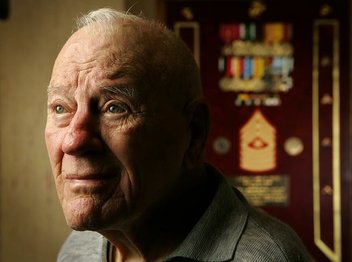
I’m glad to see that someone remembers that Guam was one of the first places hit before Pearl Harbor, Hawaii. We have to remember that when this happened, Guam was already a territory of the United Sates. I’m wondering about all the other invasion stories that happened but were marginalized because of Pearl Harbor.
At ceremonies nationwide today, aging survivors of the Dec. 7, 1941, sneak attack on Pearl Harbor will gather to remember a day that President Franklin Roosevelt famously declared would “live in infamy.”
That day remains known as Pearl Harbor Day. San Diego is home to the largest group of military survivors of the attack that killed nearly 3,000 people.
Less remembered is that within hours of the assault on Hawaii, Japanese forces attacked other U.S. military bases in the Pacific, including the Philippines, Wake Island, Midway and Guam.
Unlike at Pearl Harbor, the Japanese followed up those attacks with invasions and brutal occupations. Nearly all of the defenders either died or were taken captive for the rest of World War II.
On Guam, 150 Marines guarded the small central Pacific island, supplemented by about 300 Navy personnel assigned to a hospital and a vintage minesweeper, and a few hundred local forces.
“The guys on Guam, they were a footnote,” said Roger Mansell of Palo Alto, founder of the Web site Center for Research on Allied POWs under the Japanese. “After Pearl Harbor, Guam just disappeared off the radar.”
Harris Chuck of Vista and Tom Nixon of Murrieta were Marines based in Guam in December 1941. Both men say they have never forgotten the shock of being in the gunsights of Japanese Zeros and “Pete” bombers swooping low from the sky.
“We were being chased by a (expletive) fighter plane that was shooting us!” said Chuck, 92, still amazed by the memory.
Nixon, 87, was in charge of the barracks the morning of Dec. 8 (Guam is beyond the international date line). Some had heard rumors of the Pearl Harbor attack at morning chow, but Nixon hadn’t.
The barracks were targeted in the first bombing run. The Marines raced out of the building and to their battle stations.
As Nixon scrambled out of the building, he saw a Marine whose legs had been riddled by shrapnel. Nixon slung him over his shoulder and started running across the golf course that surrounded the barracks. He hit the deck when another bomber dived toward them.
“I laid him on the ground, and I jumped on top of him to protect him,” Nixon said. “A bomb exploded so close, I could put my hand in the crater. I still have problems from the shrapnel wounds.”
The strafing continued hourly for two days.
The defenders had few guns. The only ship, a minesweeper called the Penguin, was badly damaged in one of the early runs, and its crew sank it to keep it out of enemy hands.
Unlike at Pearl Harbor, the Guam attack wasn’t really a surprise, Mansell said. Japanese aircraft had been flying over regularly for at least two months, prompting furious American diplomatic protests. Military families had been evacuated in October, and Navy Capt. George McMillin, the military commander, had received warnings of imminent hostilities Dec. 4 and destroyed classified documents Dec. 6.
But that didn’t mean the island was equipped to rebuff an attack. The lone anti-aircraft gun was aboard the Penguin, and the defenders had only a few old machine guns and their sidearms.
About 6,000 Japanese marines swarmed ashore May 10 against token opposition, machine-gunning anyone in their way. By the end of the day, 31 civilians and 17 service members were killed.
Within two hours of the invasion, McMillin ordered the garrison to surrender after a skirmish in the main square of the capital, Agana. The Japanese commander ordered all of the military men to strip naked and sit in the sun. One Marine was killed for making what the commander thought was an insolent gesture.
Nixon and three other Marines escaped to some caves, donning native clothing to blend in with locals. They were captured when a gust of wind blew off one of the Marines’ hats, exposing blond hair. They were beaten, accused of spying and lined up against a wall to be executed. A Japanese officer spared them at the last moment.
On Christmas Eve, Nixon saw his girlfriend, a Guam native, executed for trying to smuggle him a note. It was the first of dozens of summary executions carried out against the local Chamorran population before the Americans retook the island in July 1944.
One month after the Japanese takeover, all of the military personnel and a few U.S. civilians were packed into the hold of a converted ocean liner and shipped to Japan. They were dispersed to brutal labor camps.
Nixon worked at a rock quarry and lost nearly half of his body weight. A secret diary he kept is one of the few surviving contemporaneous accounts of POW life. Although he stayed in the Marine Corps, Nixon’s captivity took a toll on his health and he was medically retired in 1955. He became an engineer and lived for 16 years in Ramona before moving to Riverside County.
Chuck fared somewhat better in captivity. Working as a stevedore unloading cargo, he became an expert at getting food. He retired from the Marine Corps as a sergeant major in 1970 and can still fit into the same uniform.
Nixon said he suffered from post-traumatic stress disorder long before the term had a name. He’s learned to cope by telling his story — first to other former POWs, later to his family and now, even to strangers.
He wants the world to know that Pearl Harbor Day isn’t only about Pearl Harbor.
References:
http://www.signonsandiego.com/news/2009/dec/07/vets-recall-guams-day-infamy/



